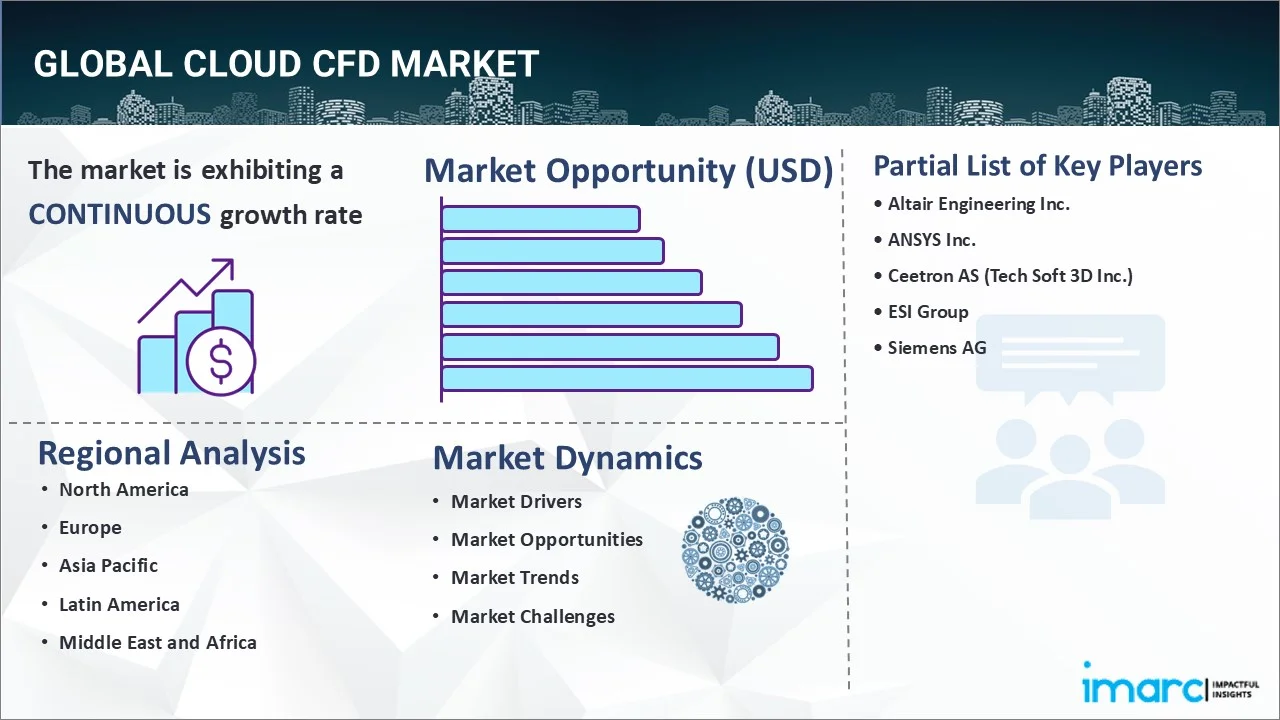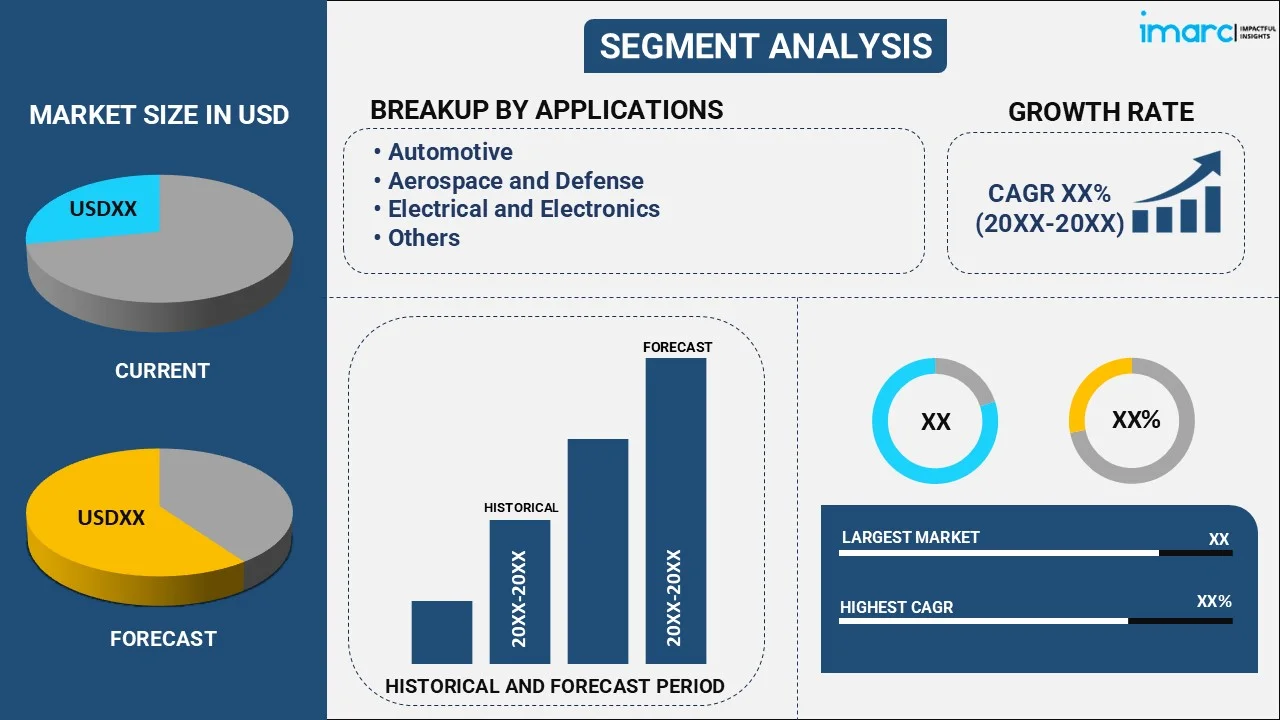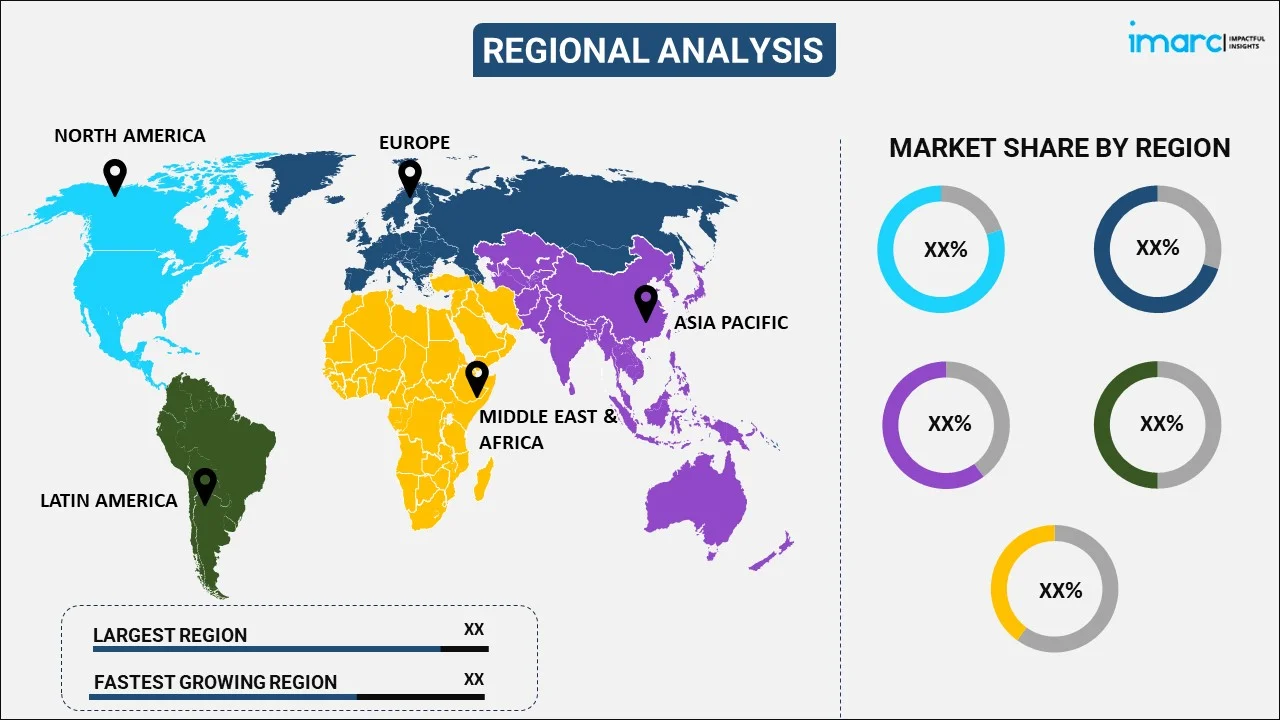
Cloud CFD Market Report by Application (Automotive, Aerospace and Defense, Electrical and Electronics, and Others), and Region 2025-2033
Cloud CFD Market Overview:
The global cloud CFD market size reached USD 2.0 Billion in 2024. Looking forward, IMARC Group expects the market to reach USD 4.2 Billion by 2033, exhibiting a growth rate (CAGR) of 8.94% during 2025-2033. The cumulative spending on aerospace applications for enhanced performance, escalating demand for cost-effective solutions, and focus on improved scalability and flexibility are some of the key factors that are impelling the growth of the market.
|
Report Attribute
|
Key Statistics
|
|---|---|
|
Base Year
|
2024
|
|
Forecast Years
|
2025-2033
|
|
Historical Years
|
2019-2024
|
|
Market Size in 2024
|
USD 2.0 Billion |
|
Market Forecast in 2033
|
USD 4.2 Billion |
| Market Growth Rate 2025-2033 | 8.94% |
Cloud CFD Market Analysis:
- Major Market Drivers: One of the key market drivers is the rising focus of key companies on reducing time to market. The increasing focus on environmental sustainability is also acting as a growth-inducing factor.
- Key Market Trends: The demand is growing because of numerous primary trends, which include the rising spending on aerospace applications and the escalating demand for cost-effective solutions.
- Geographical Trends: According to the report, North America exhibits a clear dominance, accounting for the largest market share. This is due to the rising vehicle production in the region.
- Competitive Landscape: Some of the major market players in the cloud CFD industry are Altair Engineering Inc., ANSYS Inc., Ceetron AS (Tech Soft 3D Inc.), ESI Group, Siemens AG, among many others.
- Challenges and Opportunities: One of the key challenges hindering the market growth is cost management and budget constraints. Nonetheless, collaborative workflows and ecosystems, represent the cloud CFD market recent opportunities.

Cloud CFD Market Trends:
Increasing Spending on Aerospace Applications
The growing demand for cloud CFD due to the rising spending on aerospace applications is offering a positive market outlook. Cloud CFD is used to predict the drag, lift, noise, structural and thermal loads, combustion, and performance in aircraft systems and subsystems. It is beneficial in reducing the scope of running vast and costly wind tunnel tests. In line with this, virtual simulation enables a quick turnaround of innovative new concepts and allows to evaluate those at a fraction of the cost. Apart from this, cloud computing provides the flexibility to scale up your projects without significant financial investment as compared to traditional on-premises high-performance computers (HPCs). Furthermore, companies in the industry are acquiring other players to expand their reach in the aerospace sector. For instance, on 1 May 2024, Altair acquired Research in Flight, the company that makes FlightStream®, a computational fluid dynamics (CFD) software that is widely used in the aerospace and defense sector. FlightStream® is a user-friendly and powerful flow solver that bridges the gap between high-fidelity CFD simulations and the needs of engineers and designers. It offers fast computational speeds, low hardware footprint, a streamlined user interface, and a robust aerodynamic solver, which makes it an essential tool for early-stage rapid design iterations and in-depth aerodynamic studies for aerospace and defense applications.
Growing Demand for Cost-Effective Solutions
The escalating demand for cloud CFD on account of the rising need for cost-effective solutions is propelling the growth of the market. Cloud-based CFD solutions eliminate upfront investments in hardware and software. In addition, companies can access computational power on-demand, significantly reducing capital expenditures through a pay-as-you-go model. This democratizes access to CFD simulations, particularly benefiting smaller-and medium enterprises (SMEs) and startups with limited resources. Organizations can optimize their budgets and allocate funds more strategically by only paying for the resources they use. Consequently, cost efficiency is becoming a growth-inducing factor for adopting cloud CFD, fostering innovation and leveling the playing field in engineering and design. Furthermore, market players are introducing new features that offer enhanced performance. On 21 September 2022, Convergent Science launched CONVERGE Horizon, a new cloud computing service with a focus on flexibility and affordability. The goal of CONVERGE Horizon is to provide easy access to computational resources for users of CONVERGE CFD software who are resource-limited or who do not have on-premises hardware. This new service offers a scalable and on-demand solution for running high-fidelity CFD simulations in the cloud.
Rising focus on Enhanced Scalability and Flexibility
The increasing focus on enhanced scalability and flexibility is catalyzing the cloud CFD demand. Cloud simulation allows to scale the simulations and run on as many cores as per the need of an organization. This flexibility addresses the variable computational demands of complex simulations without the constraints of on-premises infrastructure. Cloud platforms accommodate fluctuating workloads seamlessly, whether scaling up for high-fidelity analyses or scaling down for routine tasks. This scalability enables organizations to adapt to evolving project requirements, optimizing efficiency and minimizing time-to-insight. By leveraging scalable cloud resources, engineers can tackle larger simulations, explore design alternatives more comprehensively, and expedite decision-making processes, ultimately driving innovation and competitiveness. On 9 January 2023, Altair unveiled the latest updates to its simulation portfolio, Simulation 2022.2. These updates build on the enhancements brought by Simulation 2022.1 and improve Altair’s cloud elasticity and scalability, electrification, and product development capabilities. It offers an enhanced Altair One experience by providing users with flexible access to solutions, applications, data, and compute, allowing users to launch leading tools like Altair® HyperMesh®, Altair® HyperView®, Altair® SimLab®, and Altair® Inspire™ in browsers or on the desktop/laptop. In line with this, it enables users to submit solver jobs covering structural, thermal, and computational fluid dynamics (CFD), and high/low frequency electromagnetics disciplines in Altair’s scalable, elastic cloud infrastructure.
Cloud CFD Market Segmentation:
IMARC Group provides an analysis of the key trends in each segment of the market, along with cloud CFD market forecast at the global, regional, and country levels for 2025-2033. Our report has categorized the market based on application.
Breakup By Application:

- Automotive
- Aerospace and Defense
- Electrical and Electronics
- Others
Automotive accounts for the majority of the market share
The report has provided a detailed breakup and analysis of the market based on the application. This includes automotive, aerospace and defense, electrical and electronics, and others. According to the report, automotive represented the largest segment.
As per the Association of European Automobile Manufacturers (ACEA), there were around 85.4 Million motor vehicles produced across the globe in 2022. The increasing production of vehicles is catalyzing the demand for cloud CFD in the automotive sector. Cloud CFD is used in the automotive industry to design cars, trucks, buses, and other vehicles. It is useful in analyzing aerodynamics, thermal management, fuel efficiency of vehicles, and performance of the engine components and cooling systems. Moreover, cloud-based CFD is used to optimize heating, ventilation, and air conditioning (HVAC) systems within vehicles. It also facilitates collaboration among automotive manufacturers, suppliers, and engineering partners throughout the supply chain. Furthermore, it is employed to simulate vehicle crashes and analyze the impact on vehicle structures and occupant safety. It also allows automotive engineers to identify potential weaknesses in vehicle designs, optimize structural components, and enhance occupant protection systems by conducting virtual crash tests.
Breakup By Region:

- North America
- United States
- Canada
- Asia Pacific
- China
- Japan
- India
- South Korea
- Australia
- Indonesia
- Others
- Europe
- Germany
- France
- United Kingdom
- Italy
- Spain
- Russia
- Others
- Latin America
- Brazil
- Mexico
- Others
- Middle East and Africa
North America leads the market, accounting for the largest cloud CFD market share
The report has also provided a comprehensive analysis of all the major regional markets, which include North America (the United States and Canada); Asia Pacific (China, Japan, India, South Korea, Australia, Indonesia, and others); Europe (Germany, France, the United Kingdom, Italy, Spain, Russia, and others); Latin America (Brazil, Mexico, and others); and the Middle East and Africa. According to the report, North America represents the largest regional market for cloud CFD.
The increasing production of vehicles in the North America region is supporting the cloud CFD market growth. According to the Bureau of Transportation Statistics, there were approximately 9,157 vehicles produced in 2021 in the US. Besides this, the availability of robust and scalable cloud infrastructure supports the computational requirements of CFD simulations, which is strengthening the market growth. In addition, the North America region has well-established regulatory frameworks and standards that govern industries such as aerospace, automotive, and energy.
Competitive Landscape:
- The market research report has also provided a comprehensive analysis of the competitive landscape in the market. Detailed profiles of all major companies have also been provided. Some of the major market players in the cloud CFD industry include Altair Engineering Inc., ANSYS Inc., Ceetron AS (Tech Soft 3D Inc.), ESI Group, and Siemens AG.
(Please note that this is only a partial list of the key players, and the complete list is provided in the report.)
- Major players in the market are launching advanced software solutions that allow users enhanced flexibility. They are also engaging in collaboration with other companies to increase cloud CFD market revenue. For example, Ansys collaborated with Microsoft to drive innovation forward with chip development, simulation, and cloud computing on 21 March 2022. Ansys’s clients will have automatic cloud access to the latest 3rd Gen AMD EPYC processors with AMD 3D V-Cache technology. Ansys Cloud, the managed cloud service provided by Ansys and enabled on Azure, will automatically upgrade to offer the ability to use the latest AMD chips. The news product produces unprecedented performance boosts for technical computing workloads. In early testing by Azure, the company saw up to 80% improvement in large-scale CFD simulations and up to 50% improvement in explicit finite element analysis (FEA) crash tests, thereby showcasing a better decision design.
Cloud CFD Market Recent Developments:
- 7 February 2024: Ansys announced Fluent Web UI, a web-based technology that enables users to remotely access simulations from any device. Fluent Web UI provides an interface for Ansys Fluent™, an industry-leading CFD solver with native GPUs that can speed time-to-result by almost 10x. It allows users to run, control, and monitor simulations on the cloud or on-premises high-performance computing clusters.
- 16 July 2022: ESI Group, a global simulation and virtual prototyping software partner for the industry, announced a new step in its strategy to focus on its “OneESI 2024 – Focus to Grow” plan by the sale of its non-core fluids simulation software product, which represented €4.6 million of revenue in the financial year 2021 for €24 million.
Cloud CFD Market Report Scope:
| Report Features | Details |
|---|---|
| Base Year of the Analysis | 2024 |
| Historical Period | 2019-2024 |
| Forecast Period | 2025-2033 |
| Units | Billion USD |
| Scope of the Report | Exploration of Historical Trends and Cloud CFD Market Outlook, Industry Catalysts and Challenges, Segment-Wise Historical and Future Market Assessment:
|
| Applications Covered | Automotive, Aerospace and Defense, Electrical and Electronics, Others |
| Regions Covered | Asia Pacific, Europe, North America, Latin America, Middle East and Africa |
| Countries Covered | United States, Canada, Germany, France, United Kingdom, Italy, Spain, Russia, China, Japan, India, South Korea, Australia, Indonesia, Brazil, Mexico |
| Cloud CFD Companies Covered | Altair Engineering Inc., ANSYS Inc., Ceetron AS (Tech Soft 3D Inc.), ESI Group, Siemens AG, etc. |
| Customization Scope | 10% Free Customization |
| Post-Sale Analyst Support | 10-12 Weeks |
| Delivery Format | PDF and Excel through Email (We can also provide the editable version of the report in PPT/Word format on special request) |
Key Questions Answered in This Report:
- How has the global cloud CFD market performed so far, and how will it perform in the coming years?
- What are the drivers, restraints, and opportunities in the global cloud CFD market?
- What is the impact of each driver, restraint, and opportunity on the global cloud CFD market?
- What are the key regional markets?
- Which countries represent the most attractive cloud CFD market?
- What is the breakup of the market based on the application?
- Which is the most attractive application in the cloud CFD market?
- What is the competitive structure of the market?
- Who are the key players/companies in the global cloud CFD market?
Key Benefits for Stakeholders:
- IMARC’s report offers a comprehensive quantitative analysis of various market segments, historical and current market trends, market forecasts, and dynamics of the cloud CFD market from 2019-2033.
- The research study provides the latest information on the market drivers, challenges, and opportunities in the global cloud CFD market.
- The study maps the leading, as well as the fastest-growing, regional markets. It further enables stakeholders to identify the key country-level markets within each region.
- Porter's five forces analysis assists stakeholders in assessing the impact of new entrants, competitive rivalry, supplier power, buyer power, and the threat of substitution. It helps stakeholders to analyze the level of competition within the cloud CFD industry and its attractiveness.
- Competitive landscape allows stakeholders to understand their competitive environment and provides an insight into the current positions of key players in the market.
Need more help?
- Speak to our experienced analysts for insights on the current market scenarios.
- Include additional segments and countries to customize the report as per your requirement.
- Gain an unparalleled competitive advantage in your domain by understanding how to utilize the report and positively impacting your operations and revenue.
- For further assistance, please connect with our analysts.
 Request Customization
Request Customization
 Speak to an Analyst
Speak to an Analyst
 Request Brochure
Request Brochure
 Inquire Before Buying
Inquire Before Buying




.webp)




.webp)












